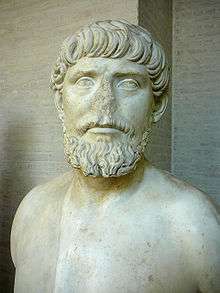Apollodorus of Damascus
Apollodorus of Damascus was a Nabatean architect and engineer from Damascus, Roman Syria, who flourished during the 2nd century AD.[1][2][3] As an engineer he authored several technical treatises, and his massive architectural output gained him immense popularity during his time[4]. He is one of the few architects whose name survives from antiquity, and is credited with introducing several Eastern innovations to the Roman Imperial style, such as making the dome a standard.
Apollodorus of Damascus | |
|---|---|
 Apollodorus of Damascus, bust from 130/140 AD in the Glyptothek | |
| Born | |
| Occupation | Architect |
| Buildings | Pantheon, Basilica Ulpia, Trajan's Forum, Temple of Trajan |
Early Life
Apollodorus was born in Damascus, Syria, at a time when it was either ruled by Nabataeans, or when they had substantial presence in it, circa 50 AD. Apollodorus is said to be of Nabataean ethnic extraction himself[5], and Damascus was part of the Roman Empire during his adulthood. Little is known of his early life, but he started his career as a military engineer[6] before meeting emperor Trajan and accompanying him during the Second Dacian War in 105 AD[7].
Work
Apollodorus was Trajan's favored architect and engineer. He designed and oversaw the construction of the Forum, Markets, and Temple, and Column of Trajan (the first monument of its kind) within the city of Rome. He is widely credited with the design of the Pantheon and in AD 106 he completed the stadium of Domitian. Outside the capitol, Apollodorus built bridges across the Danube and the Tagus in Spain and designed the triumphal arches of Trajan at Benevento and Ancona.[8] He is the author of Siege Engines (Πολιορκητικά), dedicated to an unnamed emperor, likely Trajan.[8]
.jpg)
Style
Fiorella Festa Farina, Director of the Italian Institute of Culture in Damascus, described the technical prowess of Apollodorus as stemming from his cultural roots, and that he owed his mastery to "Nabataean culture filtered through Greek modes of thought."[10] He was known for his practical and robust designs. It was likely due to his influence that domes became a standard element in Roman architecture.[11]
Death
Cassius Dio reports that Apollodorus offended Hadrian by dismissing and ridiculing the emperor's forays into architecture, which led to his banishment and death (although doubts have been raised concerning the veracity of Dio's claim).[12]
In literature
Apollodorus of Damascus plays an important role in the later part of the historical novel Empire by Steven Saylor. The (fictional) protagonist Marcus Pinarius, a talented young sculptor and architect, becomes Apollodorus' protege, accompanies him during the war in Dacia and on various building projects in Rome, and later marries Apollodorus' daughter. After Apollodorus' banishment, Pinarius takes his place as the favorite architect of Hadrian. While all that is fictional, the book follows the known facts of Apollodorus' life (and accepts the account of his death at Hadrian's hands).
See also
Notes
- George Sarton (1936), "The Unity and Diversity of the Mediterranean World", Osiris. 2: 406-463 [430]
- Giuliana Calcani, Maamoun Abdulkarim (2003), Apollodorus of Damascus and Trajan's Column: From Tradition to Project, L'Erma di Bretschneider, p. 11, ISBN 88-8265-233-5,
...focusing on the brilliant architect Apollodorus of Damascus. This famous Syrian personage represents...
- Hong-Sen Yan, Marco Ceccarelli (2009), International Symposium on History of Machines and Mechanisms: Proceedings of HMM 2008, Springer, p. 86, ISBN 978-1-4020-9484-2,
He had Syrian origins coming from Damascus
- https://www.oxfordreference.com/view/10.1093/oi/authority.20110803095419245
- Landart, Paula (2015-01-22). Finding Ancient Rome: Walks in the city. Paula Landart.
- Greek and Roman Military Writers, Routledge, 2004
- Engineers: From the Great Pyramids to Spacecraft, Dorling Kindersley Limited, 2017
- Chisholm 1911.
- Giuliana Calcani, Maamoun Abdulkarim (2003), Apollodorus of Damascus and Trajan's Column: From Tradition to Project, L'Erma di Bretschneider, p. 55, ISBN 88-8265-233-5
- Apollodorus of Damascus And Trajan's Column, Maamoun Abdulkarim, L'Erma di Bretschneider, 2003, p. 9
- Adam, Jean-Pierre (1994). Roman Building: Materials and Techniques. Routledge. p. 189.
- R. T. Ridley (1989), "The Fate of an Architect, Apollodoros of Damascus", Athenaeum. 67: 551-65.
References

- James Grout: 'Apollodorus of Damascus,' part of the Encyclopædia Romana
- Cassius Dio 'Roman History' 69.3,4
External links
